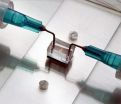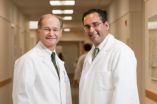(Press-News.org) Princeton engineers have developed a sensor that may revolutionize how drugs and medical devices are tested for contamination, and in the process also help ensure the survival of two species of threatened animals.
To be fair, some of the credit goes to an African frog.
In the wild, the African clawed frog produces antibacterial peptides -- small chains of amino acids -- on its skin to protect it from infection. Princeton researchers have found a way to attach these peptides, which can be synthesized in the laboratory, to a small electronic chip that emits an electrical signal when exposed to harmful bacteria, including pathogenic E. coli and salmonella.
"It's a robust, simple platform," said Michael McAlpine, an assistant professor of mechanical and aerospace engineering and the lead researcher on the project. "We think these chips could replace the current method of testing medical devices and drugs."
A paper outlining their development of the sensor was published online October 18 in the Proceedings of the National Academy of Science. The research was funded by the American Asthma Foundation and by the Air Force Office of Scientific Research.
The current testing method has a major drawback: It relies on the blood of the horseshoe crab, a species that is roughly 450 million years old. The horseshoe crab population has declined in recent years, and as a result, so too has the population of a bird that feasts on the crab.
The crab became desirable for testing because its immune system has evolved to cope with the constant threat of invasion from its bacteria-rich environment. Its blood contains antimicrobial cells, known as amebocytes, that defend the crab against bacteria -- similar to the way the peptides protect the African frog's skin.
For almost 40 years, an aqueous extract made from horseshoe crab blood cells, called Limulus amebocyte lysate (LAL), has been used for testing drugs and medical devices for contamination.
In the era before the use of these animal extracts for testing, although drugs and medical devices were sterilized, they would sometimes cause patients to develop fevers due to an immune reaction to endotoxins, which are remnants of bacteria destroyed by the sterilization process. When a sample from a drug or device is added to LAL and the solution hardens into a gel, it indicates the sample is contaminated and not safe for human use.
New approach could help save animal populations
To produce LAL, the crabs are captured and roughly 30 percent of their blood drained before they are returned to the ocean. There is disagreement on how many crabs die as a result of the procedure, but their estimated mortality rate can be as high as 30 percent, according to the United States Geological Survey.
A conservative estimate puts the number of horseshoe crabs on the Atlantic Coast between New Jersey and Virginia at between 2.3 to 4.5 million, according to the Ecological Research & Development Group. In recent years, the populations of the horseshoe crab and shore birds that rely on them for food both have been in decline, with the red knot, a rust-colored species of shore bird, of particular concern.
Each spring the bird migrates 20,000 miles from the islands of Tierra del Fuego, off the southern tip of South America, to the Delaware Bay on the east coast of the United States. From April to May, the bird feasts on horseshoe crab eggs found on beaches, nearly doubling its body weight to sustain its health for the long flight south.
Studies have discovered a precipitous decline in the red knot population. One study by researchers at the University of Toronto found that the Tierra del Fuego population of red knots declined from 53,000 birds to 27,000 birds between 2000 and 2002. The decline has been linked to the reduction in the number of horseshoe crabs, as a result of harvesting their blood for medical testing and their use as fishing bait for eel and conch.
In response, Delaware, Maryland and New York have limited the number of crabs that can be harvested each year to less than 150,000, and New Jersey has implemented a moratorium on harvesting the crabs.
In 2009, since implementing the measures, the number of red knots visiting Delaware Bay was estimated at 24,000, up from 18,000 the year before, but still far lower than the population of 100,000 to 150,000 of two decades ago.
McAlpine and Manu Mannoor, a Princeton graduate student who worked on the project, hope that technology based on their electronic chip will eventually replace LAL as the standard for contamination testing, obviating the need for horseshoe crab blood and helping both the crabs and the red knots rebound.
At the same time, producing this new sensory device would not put pressure on the frog species. "No frogs were harmed in the making of this sensor," he said.
INFORMATION:
New sensor derived from frogs may help fight bacteria and save wildlife
Sensor uses frog peptides to test for drug and medical device contamination
2010-10-20
ELSE PRESS RELEASES FROM THIS DATE:
To be good, sometimes leaders need to be a little bad
2010-10-20
Outgoing. Assertive. Calm. Practical. Decisive. These are obvious qualities that one would want in their leaders.
But what about, say, arrogant, hesitant, overly dramatic, inflexible, or being a "yes-man"? A new study has found that when it comes to leading, some of those negative personality traits aren't such a bad thing, either.
The work, by researchers in the University of Nebraska-Lincoln's College of Business Administration, studied the development of leaders over a three-year period. Prior research had established that clearly positive personality qualities ...
CRN responds to JAMA fish oil study
2010-10-20
WASHINGTON, D.C., October 19, 2010—In response to a study regarding fish oil use during pregnancy published in the October 19 issue of the Journal of the American Medical Association (JAMA), the Council for Responsible Nutrition (CRN), the leading trade association for the dietary supplement industry, reminds pregnant and lactating women of the undisputed importance of consuming the recommended amounts of docosahexaenoic acid (DHA) throughout pregnancy. This can be done by eating two servings of fatty fish, such as sardines or anchovies, per week, or taking fish oil supplements ...
University of Houston professor taking next step with graphene research
2010-10-20
The 2010 Nobel Prize in Physics went to the two scientists who first isolated graphene, one-atom-thick crystals of graphite. Now, a researcher with the University of Houston Cullen College of Engineering is trying to develop a method to mass-produce this revolutionary material.
Graphene has several properties that make it different from literally everything else on Earth: it is the first two-dimensional material ever developed; the world's thinnest and strongest material; the best conductor of heat ever found; a far better conductor of electricity than copper; it is virtually ...
New UGA research shows people are better at strategic reasoning than was thought
2010-10-20
Athens, Ga. – When we make decisions based on what we think someone else will do, in anything from chess to warfare, we must use reason to infer the other's next move—or next three or more moves—to know what we must do. This so-called recursive reasoning ability in humans has been thought to be somewhat limited.
But now, in just-published research led by a psychologist at the University of Georgia, it appears that people can engage in much higher levels of recursive reasoning than was previously thought.
"In fact, they do it fairly easily and automatically," said Adam ...
Recycling pacemakers may alleviate burden of heart disease across the globe
2010-10-20
ANN ARBOR, Mich. – Millions worldwide die each year because they can't afford a pacemaker. Meanwhile heart patients in the United States say they'd be willing to donate theirs after death to someone in need.
In the current issue of Circulation, experts at the University of Michigan Cardiovascular Center examine the legality and logistics of collecting pacemakers, after they are removed for burial or cremation, for sterilization and reuse across the globe.
Small humanitarian efforts have shown reusing pacemakers is safe and effective with little risk of infection and ...
Cheaper, more effective treatment of type 1 Gaucher disease possible
2010-10-20
Researchers at Yale School of Medicine have found that new disease pathways involving more than one cell type leads to Type 1 Gaucher disease, a rare genetic disorder in which fatty substances called glycosphingolipids accumulate in cells, resulting in liver/spleen enlargement, osteoporosis, bone pain, and increased risk of cancer and Parkinson's disease.
The new findings could lead to less expensive and more effective ways to treat the disorder, which affects about 1 in 50,000 people in the general population. Those of Eastern and Central European (Ashkenazi) Jewish ...
Devastating impact of spinal osteoporotic fractures revealed on World Osteoporosis Day
2010-10-20
A new report issued by the International Osteoporosis Foundation (IOF) for World Osteoporosis Day puts the spotlight on the severe impact of spinal fractures and calls on health professionals to recognize the signs of these fractures in their patients.
"The widespread under–diagnosis and lack of treatment of spinal fractures, leaves millions of people around the world with chronic pain, deformity, disability and at high risk of future fractures," says Professor John Kanis, President of the IOF.
As many as two-thirds of spinal osteoporotic fractures are not recognized ...
New ratings of American hospitals released with quality study by HealthGrades
2010-10-20
GOLDEN, Colo. (October 20, 2010) – A new independent study by HealthGrades of patient outcomes at America's hospitals found that patients at 5-star rated hospitals had a 72% lower risk of dying when compared with patients at 1-star-rated hospitals -- an enormous gap that has held steady over the past years even as overall mortality rates have improved. According to the study, if all hospitals performed at the level of 5-star rated hospitals over the three years studied, 232,442 Medicare lives could potentially have been saved.
Released today, the Thirteenth Annual HealthGrades ...
TEEB report puts world's natural assets on the global political radar
2010-10-20
Nagoya, Japan, 20 October 2010– The economic importance of the world's natural assets is now firmly on the political radar as a result of an international assessment showcasing the enormous economic value of forests, freshwater, soils and coral reefs, as well as the social and economic costs of their loss, was the conclusion of The Economics of Ecosystems and Biodiversity (TEEB) report launched today by TEEB study leader, Pavan Sukhdev.
"TEEB has documented not only the multi-trillion dollar importance to the global economy of the natural world, but the kinds of policy-shifts ...
BookWhirl.com Features The Healers by Thomas Heric and Cheryl Madeleine Lodico
2010-10-20
For the month of October, BookWhirl.com features the book The Healers by Thomas Heric and author Cheryl Madeleine Lodico. The featured book, The Healers by Thomas Heric is a suspense thriller about the dark future of health care. The featured author is retired teacher, Cherul Madeleine Lodico, who successfully fulfilled her dream of being an author.
The Healers is the first book in Thomas Heric's new series. Set in the year 2021, The Healers introduces the mysterious Aesculapian Healers who offer complete cures of most illnesses with a money-back guarantee. The main ...
LAST 30 PRESS RELEASES:
Strategic river sensors could have forewarned of Texas Camp flood disaster
Drone sampling of whale breath reveals first evidence of potentially deadly virus in Arctic
Roman soldiers defending Hadrian’s Wall infected by parasites, study finds
Pinochet’s prisoners were tormented with music but still found solace in it, a new book reveals
Fertility remains high in rural Tanzania despite access to family planning
AI-assisted device can improve autism care access
Kinetic careers
Uncovering how parasitic plants avoid attacking themselves to improve crop resistance
Nanoparticle vaccine strategy could protect against Ebola and other deadly filoviruses
Study finds brain care score can predict risk of stroke across racial groups
Key lung immune cells can intensify allergic reactions
Do hormones explain why women experience more gut pain?
New materials conduct ions in solids as easily as in liquids
Breakthrough of the Year: Renewable energy begins to eclipse fossil fuel-based sources
LLM use is reshaping scientific enterprise by increasing output, reducing quality and more
Introducing LightGen, a chip for ultra-fast, ultra-efficient generative AI
Astronomers see fireworks from violent collisions around nearby star
ACC/AHA issue new guideline on managing congenital heart disease in adults
Cosmic crash caught on camera
Is talented youth nurtured the wrong way? New study shows: top performers develop differently than assumed
Ants: An untapped resource in the development of antibiotics?
Archaeologists use AI to create prehistoric video game
Mitochondria migrate toward the cell membrane in response to high glucose levels
Tiny viral switch offers hope against drug-resistant bacteria
Most parents aware of early peanut introduction guidelines, but confused about details
HPV vaccine can protect against severe lesions of the vulva and vagina
Virtual care provision and emergency department use among children and youth
Quadrivalent HPV vaccine and high-grade vulvovaginal lesions
Insights into dry eyes gained from stem cell-derived tear glands
Researchers identify 166 human pluripotent stem cell lines available for use in clinical applications
[Press-News.org] New sensor derived from frogs may help fight bacteria and save wildlifeSensor uses frog peptides to test for drug and medical device contamination



